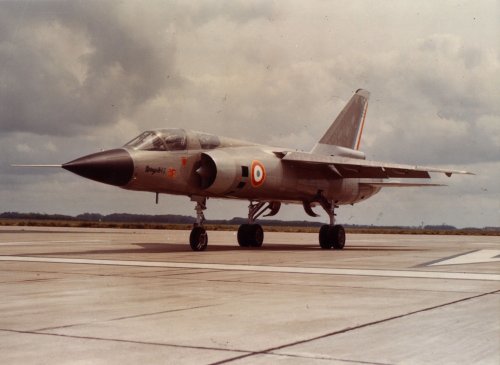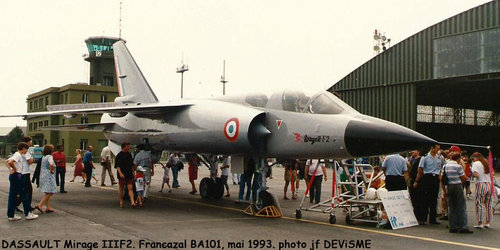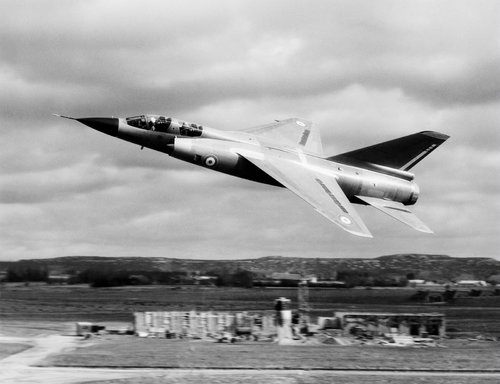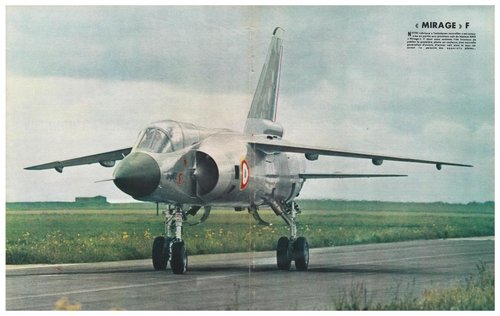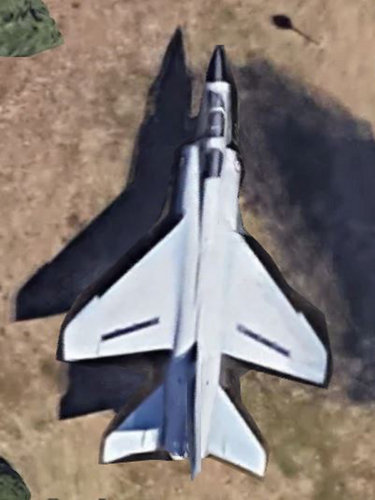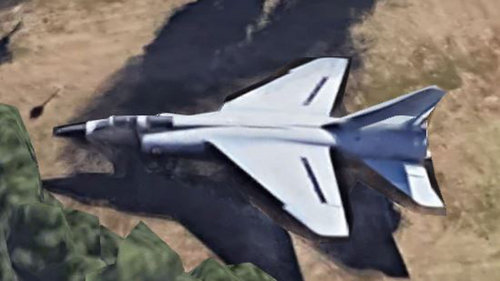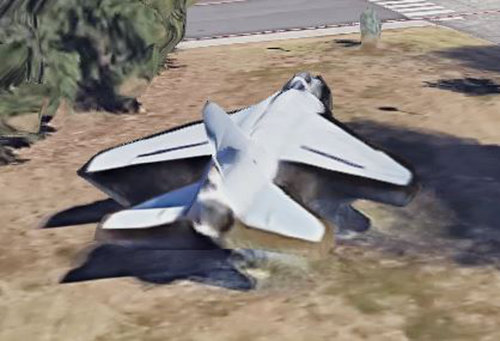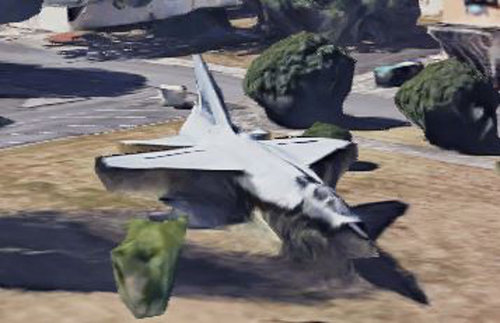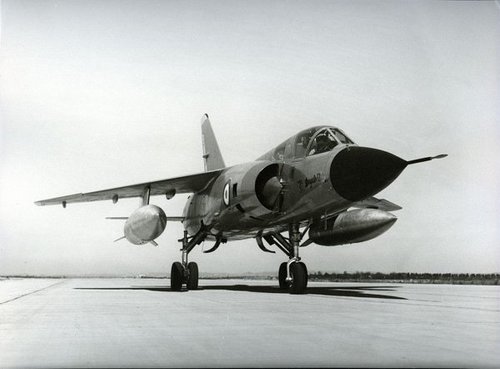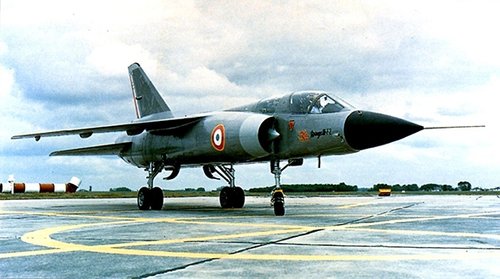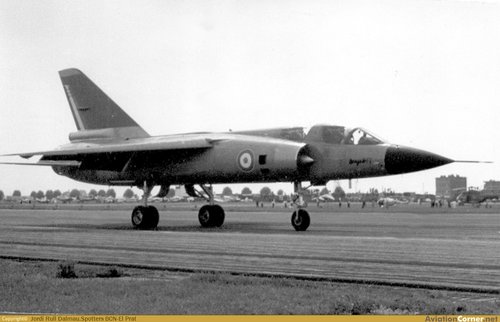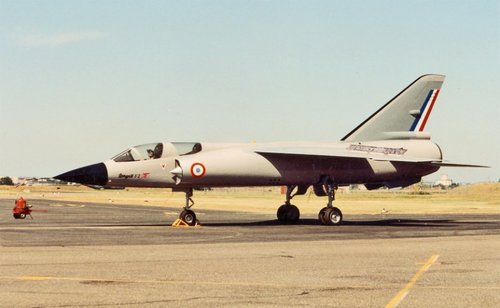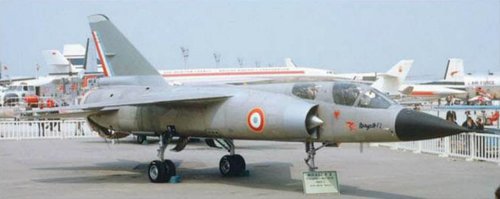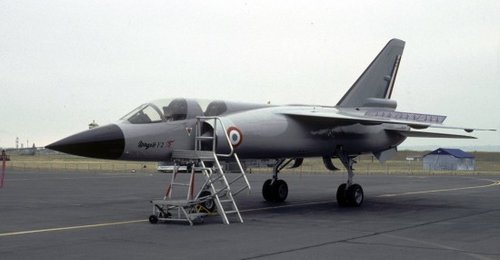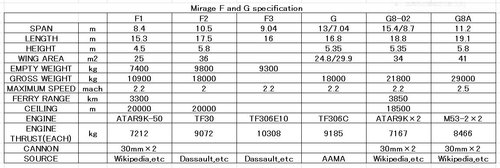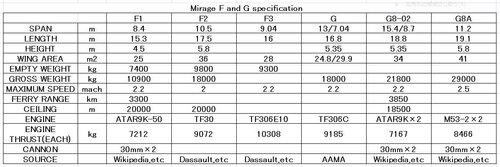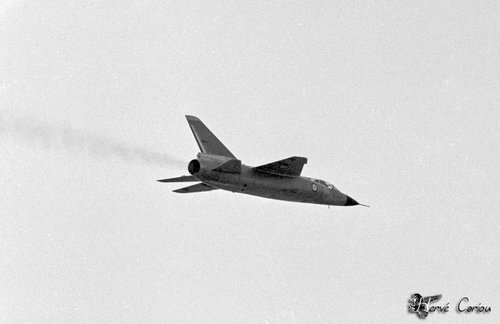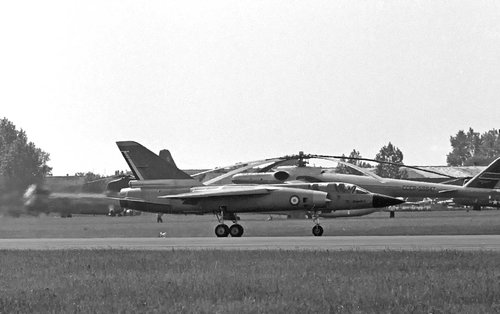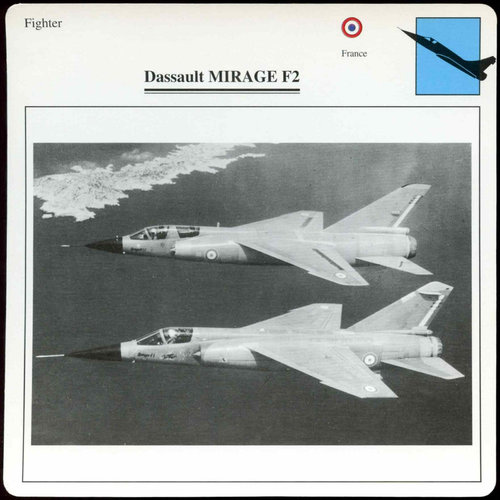You are using an out of date browser. It may not display this or other websites correctly.
You should upgrade or use an alternative browser.
You should upgrade or use an alternative browser.
Mirage F2 and F3
- Thread starter Archibald
- Start date
- Joined
- 26 May 2006
- Messages
- 34,796
- Reaction score
- 15,680
here is a drawing to Dassault Mirage F-2.
It was from L+K 4/1967.
blackkite
Don't laugh, don't cry, don't even curse, but.....
- Joined
- 31 May 2007
- Messages
- 8,806
- Reaction score
- 7,669
This F2 drawing is excellent especially area ruled fuselage shape. But unfortunately wing fillet is omitted to indicate fuselage line.
Please enjoy beautiful fuselage shape. I feel F2 is the most beautiful Mirage.

 aerobase.over-blog.com
aerobase.over-blog.com

 www.dassault-aviation.com
www.dassault-aviation.com
Please enjoy beautiful fuselage shape. I feel F2 is the most beautiful Mirage.

Développé dans les années 60, le Mirage III F2 était un bombardier de pénétration à basse altitude tous temps, puis l'Armée de l'Air abandonne le programme … - aérobase
photographies commentées d'avions et d'hélicoptères civils et militaires

Mirage III F2 F3: origins, characteristics and performance data
On June 12, 1966, at Istres, Jean Coureau took off in a Mirage III F2 01, based on a Mirage III and equipped with a sharply sweptback and lift augmented high wing.
Attachments
Last edited:
- Joined
- 30 November 2007
- Messages
- 1,126
- Reaction score
- 586
Sadly many of my attached images disappeared - https://www.secretprojects.co.uk/th...ssault-mirage-f2-prototype.12565/#post-123238
Terry (Caravellarella)
Terry (Caravellarella)
- Joined
- 11 March 2006
- Messages
- 8,618
- Reaction score
- 3,762
Sadly many of my attached images disappeared - ...
This may be a result of those photos just linked and not attached.
I've merged the two threads, to avoid duplication.
- Joined
- 13 August 2007
- Messages
- 8,402
- Reaction score
- 10,859
I made some "recherché"
The F2 prototype was disassemble in 1967 to become Mirage G (F2 - Fuselage and Engine)
Sadly the Mirage G crashed on 13 January 1971 and was destroyed...
What happened to F-3 mock up no info, likely they re-used it for Mirage G4/8 Mockup or scraps it...
The F2 prototype was disassemble in 1967 to become Mirage G (F2 - Fuselage and Engine)
Sadly the Mirage G crashed on 13 January 1971 and was destroyed...
What happened to F-3 mock up no info, likely they re-used it for Mirage G4/8 Mockup or scraps it...
I made some "recherché"
The F2 prototype was disassemble in 1967 to become Mirage G (F2 - Fuselage and Engine)
Sadly the Mirage G crashed on 13 January 1971 and was destroyed...
What happened to F-3 mock up no info, likely they re-used it for Mirage G4/8 Mockup or scraps it...
Michel: this is not quite right. The Mirage G and F2 were different airframes. The G crashed but the F2 still exists. Somewhere on this thread, 12 years ago, or on another forum, I said it was at the CEAT in Balma, in a suburb of Toulouse. CEAT is destructive testing of airframes. Fortunately the F2 escaped that fate and has spent the last 50 years or so (it last flew in 1969) outside the CEAT.
I asked once whether it was to be preserved or not; the CEAT answered the Ailes anciennes de Toulouse (now Aeroscopia) was aware it was there.
To be fair, I think the Ailes Anciennes and CEAT have kind of partnership: the aircraft won't move but they take care of it. Better than nothing.
The Mirage F2 can be clearly seen on Google Earth and also on Géoportail.
Balma Map | France Google Satellite Maps
Balma google map. Satellite image of Balma, France and near destinations. Travel deals.
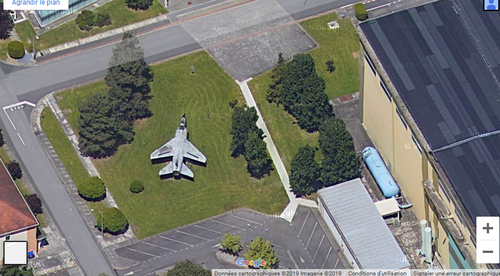
LMAO most of Google search results for "Mirage F2""CEAT" are me myself and me, on varied forums, since 2006
Details of the undercarriage !
Détails - Phaedra-Models
Détails de trains d'atterrissage Dassault Mirage F-2 . Mirage F-2 landing Gears close-up .
Last edited:
The Mirage F3 might have been more than a mockup. Metal was being cut before the F1 prevailed, in the first half of 1967.
Somewhere on the (french speaking) web there it a tantalizing bit of discussion saying that a couple of Mirage F3 airframes were being build in 1966-67 but scrapped circa March 1967 without ever flying.
They ended in a scrapyard at Melun Villaroche, the AdA flight test center before it moved to Istres.
Fact is that fate of unfinished Dassault prototypes is usually very unclear. For example took me a while to learn the exact fate of the ACF after December 1975 and its cancellation, Scrapped, it was (Le Fana got some rare pictures of the prototype during construction).
Same for the Etendard II, IV and VI, there were a whole bunch of prototypes with all kind of different engines between 1956 and 1959, when the Aeronavale took over the Etendard series. There was a blown-flaps one with a system somewhat borrowed from the Buccaneer.
Somewhere on the (french speaking) web there it a tantalizing bit of discussion saying that a couple of Mirage F3 airframes were being build in 1966-67 but scrapped circa March 1967 without ever flying.
They ended in a scrapyard at Melun Villaroche, the AdA flight test center before it moved to Istres.
Fact is that fate of unfinished Dassault prototypes is usually very unclear. For example took me a while to learn the exact fate of the ACF after December 1975 and its cancellation, Scrapped, it was (Le Fana got some rare pictures of the prototype during construction).
Same for the Etendard II, IV and VI, there were a whole bunch of prototypes with all kind of different engines between 1956 and 1959, when the Aeronavale took over the Etendard series. There was a blown-flaps one with a system somewhat borrowed from the Buccaneer.
- Joined
- 13 August 2007
- Messages
- 8,402
- Reaction score
- 10,859
Michel: this is not quite right. The Mirage G and F2 were different airframes. The G crashed but the F2 still exists.
I so Happy to be so wrong
blackkite
Don't laugh, don't cry, don't even curse, but.....
- Joined
- 31 May 2007
- Messages
- 8,806
- Reaction score
- 7,669
Last edited:
Comaero says the following (page 76 of the above document)
There was first the Mirage F2-01, one of its kind.
Then contracts were passed with Dassault for the F3 that included
- a mockup
- turning the second F2 - F2-02 - into F3-01
- building a brand new F3-02
So kind of 2.5 Mirage F3 were partially build (the 0.5 being the mockup) and then in spring 1967 all this was scrapped.
blackkite
Don't laugh, don't cry, don't even curse, but.....
- Joined
- 31 May 2007
- Messages
- 8,806
- Reaction score
- 7,669
- Joined
- 19 July 2016
- Messages
- 4,255
- Reaction score
- 3,440
Interesting thought, perhaps if enough of us ask? Not likely but then again it is only a certain number of shopping days before THAT day so anything can happen in the next half century.........
Charlesferdinand
amateur theologian
- Joined
- 24 October 2013
- Messages
- 172
- Reaction score
- 272
Well in J-C Carbonel's French Secret Projects, Postwar Fighters, there is a three-view of the F3, sourced Dassault Aviation.I want to ask Dassault to contribute F3 official three side view drawing.
blackkite
Don't laugh, don't cry, don't even curse, but.....
- Joined
- 31 May 2007
- Messages
- 8,806
- Reaction score
- 7,669
Thanks I know. I want to see mare detailed drawing, for example very exciting F2 three side view in "Le Mirage F1 Vol.1" page 24.
This book also include same F3 three side view drawing.
This book also include same F3 three side view drawing.
- Joined
- 19 July 2016
- Messages
- 4,255
- Reaction score
- 3,440
I have emailed Dassault so I will forward any response.
blackkite
Don't laugh, don't cry, don't even curse, but.....
- Joined
- 31 May 2007
- Messages
- 8,806
- Reaction score
- 7,669
Hi! More images. Enjoy.

 germo43.skyrock.com
germo43.skyrock.com

 www.dassault-aviation.com
www.dassault-aviation.com

 www.avionslegendaires.net
www.avionslegendaires.net

MIRAGE F2
Seul prototype de chasseur tactique lourd 1966 1 réacteur SNECMA TF-306A 9000kgp Équipage :2 Le F2 est ou était exposé devant devant le bâtiment de direction du CEAT ( Centre Essais Aéronautique de...

Group News - Dassault Aviation
Find all Dassault Aviation Group news. © Dassault Aviation - ERIDIA/ A. Paringaux/ V. Almansa
AviationCorner.net - Aircraft photography - Dassault Mirage F2
AviationCorner.net - Aviation site for enthusiasts - Aircraft Photography and meeting point for spotters from around the world
www.aviationcorner.net

Dassault Mirage F2 - avionslegendaires.net
Description du prototype français : Dassault Mirage F2, Prototype de chasseur tactique lourd, construit par Dassault, en 1966, pour France
Attachments
Last edited:
What it is somewhat remarquable is that the F2, F3 and G airframes were almost identical. It was somewhat a matter of swapping a 2-men cockpit for a single seater, or replace the swept wing by VG. By all accounts, one F2, one G, and 2 F3 were build or almost build, four airframes. To be a fly on the wall at Dassault in 1965-68 and watch these four airframes evolve into different aircraft...
A similar thing had happened a decade earlier. When you think about it, by 1957 the Super Mystère B2 and the prototypes Mirage III-01 and Etendard IV (all flown in 1955-1956) shared the same Atar 101G turbojet (the Etendard having a 101E - a 101G without the reheat). In turn the rear fuselage (lets call it the "Atar rump" ) was somewhat common to all three aircraft. Which then differed by
- the intake: frontal on the SMB-2, side-mounted on the Etendard and Mirage, the later having "mices" inside for supersonic flight
- the wing: swept wing for the SMB-2 and Etendard IV, a delta for the Mirage III
This is kind of unique in aviation history or at least the jet age - AFAIK. Same engine (101E / 101G) same rear fuselage, mated to different intakes and wings. Kind of modular fighter.
If one bought a SMB-2, an Etendard IV and a Mirage III 1/72 scale models, it would be possible to create hybrids - a tailed or no-tail delta SMB-2 or a supersonic Etendard with "mices" and reheat from the Mirage III. or a swept wing Mirage III.. wait, that's the F1, it had the Mirage V fuselage.
edit: Deleted one of my earlier post as unuseful.
A similar thing had happened a decade earlier. When you think about it, by 1957 the Super Mystère B2 and the prototypes Mirage III-01 and Etendard IV (all flown in 1955-1956) shared the same Atar 101G turbojet (the Etendard having a 101E - a 101G without the reheat). In turn the rear fuselage (lets call it the "Atar rump" ) was somewhat common to all three aircraft. Which then differed by
- the intake: frontal on the SMB-2, side-mounted on the Etendard and Mirage, the later having "mices" inside for supersonic flight
- the wing: swept wing for the SMB-2 and Etendard IV, a delta for the Mirage III
This is kind of unique in aviation history or at least the jet age - AFAIK. Same engine (101E / 101G) same rear fuselage, mated to different intakes and wings. Kind of modular fighter.
If one bought a SMB-2, an Etendard IV and a Mirage III 1/72 scale models, it would be possible to create hybrids - a tailed or no-tail delta SMB-2 or a supersonic Etendard with "mices" and reheat from the Mirage III. or a swept wing Mirage III.. wait, that's the F1, it had the Mirage V fuselage.
edit: Deleted one of my earlier post as unuseful.
- Joined
- 21 May 2006
- Messages
- 2,979
- Reaction score
- 2,234
Ohhh, look at the landing gear on that!!Oh sorry. But never mind. No doubt Mirage is very beautiful!!
Yes, I agree blackkite, the Mirage F2 was very beautiful; let us hope she will be saved and preserved properly.
View attachment 617993
Terry (Caravellarella)
Regards
Pioneer
I think that Mirage F3 wing area was 28 m2, can't remember where I red that, maybe in the COMAERO document I linked above thread.
The Mirage F1 is really a 0.90 Mirage F3. Dassault really didn't changed the basic geometry between the F1 and the F3. It is no surprise the F1 crushed the F3, it offered the same basic performance at lower cost and with a French engine. Its supersonic performance might be actually better, since turbojets are better at high speed than turbofans, plus the TF30 had a diameter of 1.25 m versus 0.80 m for the Atar - lower drag.
As far as range and fuel consumption go however the F3 would have been much better for the same reasons above, but then again, AdA did not really cared about long range fighters or loitering time. West Germany would be the battle front, and we had a frontier with it.
The Mirage F1 is really a 0.90 Mirage F3. Dassault really didn't changed the basic geometry between the F1 and the F3. It is no surprise the F1 crushed the F3, it offered the same basic performance at lower cost and with a French engine. Its supersonic performance might be actually better, since turbojets are better at high speed than turbofans, plus the TF30 had a diameter of 1.25 m versus 0.80 m for the Atar - lower drag.
As far as range and fuel consumption go however the F3 would have been much better for the same reasons above, but then again, AdA did not really cared about long range fighters or loitering time. West Germany would be the battle front, and we had a frontier with it.
blackkite
Don't laugh, don't cry, don't even curse, but.....
- Joined
- 31 May 2007
- Messages
- 8,806
- Reaction score
- 7,669
Thanks a lot.

 www.dassault-aviation.com
www.dassault-aviation.com
 www.aamalebourget.fr
www.aamalebourget.fr

 en.wikipedia.org
en.wikipedia.org

 fr.wikipedia.org
fr.wikipedia.org

 en.wikipedia.org
en.wikipedia.org

Mirage III F2 F3: origins, characteristics and performance data
On June 12, 1966, at Istres, Jean Coureau took off in a Mirage III F2 01, based on a Mirage III and equipped with a sharply sweptback and lift augmented high wing.
LE MIRAGE G8
 www.aamalebourget.fr
www.aamalebourget.fr

Dassault Mirage F2 - Wikipedia

Avion de combat futur — Wikipédia

Dassault Mirage G - Wikipedia
Attachments
Last edited:
blackkite
Don't laugh, don't cry, don't even curse, but.....
- Joined
- 31 May 2007
- Messages
- 8,806
- Reaction score
- 7,669
Models.
Maquette d'etude et d'exposition Dassault Aviation MEE et Fradet
Maquettes avions d'exposition Dassault Aviation et autres
maquettes-dassault-mee.e-monsite.com
Models.
Maquette d'etude et d'exposition Dassault Aviation MEE et Fradet
Maquettes avions d'exposition Dassault Aviation et autresmaquettes-dassault-mee.e-monsite.com
That website is a treasure trove.
blackkite
Don't laugh, don't cry, don't even curse, but.....
- Joined
- 31 May 2007
- Messages
- 8,806
- Reaction score
- 7,669
Hi!

 bdd.deltareflex.com
bdd.deltareflex.com


Mirage F2 - 01 | Dassault Aviation
Le Bourget | 06/1967 | Salon du Bourget 1967 | Herve CARIOU

Mirage: Prototipo F2 - DFNS.net en Español
Dassault Mirage F2 WikipediaMirage F2Tipo Avión de ataqueFabricante Dassault AviationPrimer vuelo 12 de junio de 1966Estado CanceladoN.º construidos 1 prot
es.dfns.net
Attachments
- Joined
- 19 July 2016
- Messages
- 4,255
- Reaction score
- 3,440
I did get a reply from Dassault.
"Dear Madam/Sir,
Thank you very much for your interest in our company and our aircraft.
Nonetheless we cannot answer to your request.
With some research, we don't have any public documentation about your demand.
Thank you for your comprehension,
Regards,
The webmaster".
I did expect something like this to be honest.
"Dear Madam/Sir,
Thank you very much for your interest in our company and our aircraft.
Nonetheless we cannot answer to your request.
With some research, we don't have any public documentation about your demand.
Thank you for your comprehension,
Regards,
The webmaster".
I did expect something like this to be honest.
I did get a reply from Dassault.
"Dear Madam/Sir,
Thank you very much for your interest in our company and our aircraft.
Nonetheless we cannot answer to your request.
With some research, we don't have any public documentation about your demand.
Thank you for your comprehension,
Regards,
The webmaster".
I did expect something like this to be honest.
Thanks for trying anyway.
- Joined
- 19 July 2016
- Messages
- 4,255
- Reaction score
- 3,440
Welcome, Sir, worth a go.
blackkite
Don't laugh, don't cry, don't even curse, but.....
- Joined
- 31 May 2007
- Messages
- 8,806
- Reaction score
- 7,669
Thanks for trying,too.
Dassault is in good faith just to give you a reply.
I asked the US Air Force Museum about the P-75 fighter, but there was no answer.
I like Sophie Marceau.
Dassault is in good faith just to give you a reply.
I asked the US Air Force Museum about the P-75 fighter, but there was no answer.
I like Sophie Marceau.
Last edited:
- Joined
- 19 July 2016
- Messages
- 4,255
- Reaction score
- 3,440
As they say over here, "You pay your money and have a go". I got a quite decent reply from Rolls Royce about the Meteor (Technically a Rover project) including a standing invite to visit and measure up their example.
- Joined
- 27 September 2006
- Messages
- 6,387
- Reaction score
- 6,770
The English love/hate affair with France extends of course to aircraft. Although they do not have the muscle of their US equivalents, France's Mirage family is as French as Catherine Deneuve or for us older chaps, BB.
Mirages look the part. There is even a French comic strip about them..
Mirages look the part. There is even a French comic strip about them..
blackkite
Don't laugh, don't cry, don't even curse, but.....
- Joined
- 31 May 2007
- Messages
- 8,806
- Reaction score
- 7,669
Hi!

 picclick.co.uk
picclick.co.uk

Dassault Mirage F2 - Aircraft - D1 075 108.08 - Edito Card • £0.99
DASSAULT MIRAGE F2 - Aircraft - D1 075 108.08 - Edito Card - £0.99. Dassault Mirage F2 - Aircraft - D1 075 108.08 - Edito Card Click to Enlarge Make: Edito -Service Year : 1990 Size : 147mm X 148mm Language : English Information On Back Single Card As Seen In Scan Free Shipping On Any Amount Of...
Attachments
Similar threads
-
C-135FR alternatives: Vautours and Caravelles aerial tankers
- Started by Archibald
- Replies: 9
-
-
-
-
Speculative Mirage III upgrade path for a fictitious nation
- Started by Blackscorpy
- Replies: 18

